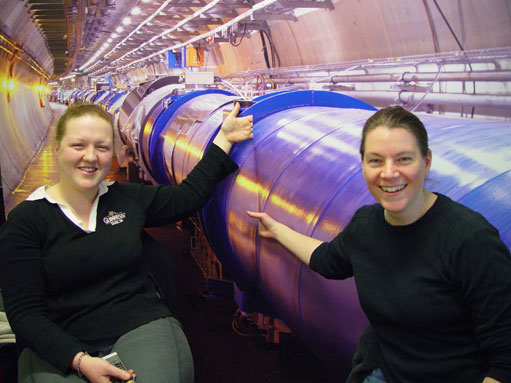
ATLAS e-News
23 February 2011
Masterclasses: particle primer
8 March 2010

Andr�e Robichaud-Véronneau (left) and Anja Vest (right) of ATLAS reveal the crack in their backdrop for the video conferences (courtesy of Konrad Jende).
It’s that time of year – the Particle Physics Masterclasses are going into their third and final week. The number of student participants has climbed to 6700 in the program’s sixth year, with ten more institutes added to last year’s 80. Although the event is organised by the European Particle Physics Outreach Group, participants hail from North and South America as well, with a total of 23 countries involved.
High school physics students attend day-long sessions at their nearest participating university or research institute, spending their mornings learning the basics of particle physics in lectures. In the afternoon, they are let loose on LEP data, identifying and calculating the rates of Z0 decays.
The sessions wrap up with an hour-long video conference chaired by a pair of young physicists at CERN, usually each from a different LHC experiment. Three of this year’s moderators are Katharine Leney and Andrée Robichaud-Véronneau of ATLAS and Marco Gersabeck of LHCb.
The video conferences open with 15 to 20 minutes for general questions, but this can stretch to half an hour. “That’s both the most interesting and most challenging part,” according to Marco, a CERN fellow. “They really come up with any kind of random question about CERN or physics or anything related to that.”
“But then you get also questions like, ‘I am a student from Poland and I want to work at CERN one day. I liked it so much today that I want to do this for life – how do I do this?’” says Andrée, a PhD student at the University of Geneva. She believes that questions like this are indicative of the program’s success. More outgoing groups of students are often so curious that question time must be cut off, to be picked up again at the end of the video conference.
The moderators then steer the discussion on to sharing the results from each institute’s study of Z0 decays, counting up decays to electrons, muons, taus and quarks. “We discuss those and talk about how, when you’re working in big collaboration, your results are all combined together and you end up with results that are better than if you were working alone,” says Katharine, a PhD student with the University of Liverpool.
The last 15 to 20 minutes is spent on a ten-question quiz, for which the pair of students with the most correct answers can earn CERN T-shirts. In sessions like Andrée’s, when the questions started up again after the quiz, most students stayed on to hear the answers. “Their motivation was stunning,” she says.
Katharine recalls more Angels and Demons related questions in 2008, though Andrée’s team fielded some on black holes. Other queries included how positrons are produced, the scientific implications of the Higgs, how many times LHC protons will circulate per second, and how antimatter is detected. “It was quite funny but also quite challenging to come up with the right answers there, and also to pitch them at a level that is understandable for the students,” says Marco.
He found out about the program through an outreach mailing list, after working with the Weltmaschine exhibition in Berlin’s central train station. Katharine jumped in unexpectedly two years ago. “I ended up covering for a friend on short notice,” she says, co-moderating his video conferences when he had to return to the UK. Luckily, she was surrounded by experienced people, and after witnessing the enthusiasm of the students, she decided to sign up herself the following years.
Like Katharine, Andrée would like to participate again. “The outreach part of our work, we sometimes neglect,” she says. “This is a marvelous experience that I would have liked to be able to attend when I was a high school student!”
If you’re interested in getting involved next year, as a moderator or in some other capacity, contact Uta Bilow at Uta.Bilow[at]physik.tu-dresden.de
 Katie McAlpineATLAS e-News
|